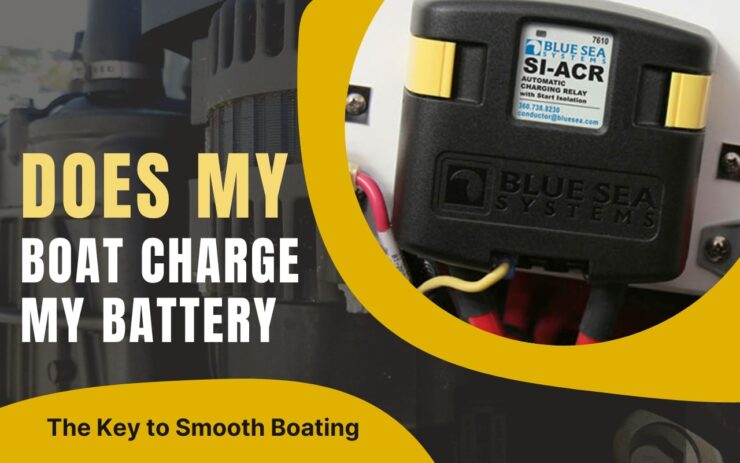Ran out of battery in the middle of nowhere? Well, in situations such as this, we desperately look for alternatives to charge our batteries. Charging the batteries through the boat does not seem like a distant idea at that time.
So, the big question is, does my boat charge my batteries?
To answer your question, Yes, your boat can charge your batteries. But you will need to have the outboard running for that. The alternator will take the responsibility to recharge the battery if the outboard is running. This will happen to compensate for the power used for starting the motor.
Sounds relaxing? We have got an elaborated version of this down below. If you want a full demonstration of your query then don’t wait.
Join us and have a brief knowledge of how the boat charges batteries.
Table of Contents
ToggleHow Do Outboards Charge Batteries?
Whether the outboard charges the batteries is among the most concern. Although it does charge the batteries, it depends on some variables.
Such as the types of outboard you are using. A two-stroke engine charges the batteries differently than a four-stroke engine.
Some boats contain charging circuits. They use an alternator to charge both the in-house and starting batteries. Johnson outboard charging is an example. Here, both of the batteries charge at the same time. Therefore, it is much more efficient.
Using a solar panel for charging purposes is also an efficient method to charge the batteries. But the tradeoff of using solar panels is that it is quite expensive. Also, it is heavily reliant on the weather as well. So, it will not be able to provide service at all times.
Does the Horse Power Matter?
The majority of the time, people don’t discuss or inquire about horsepower in relation to recharging the boat’s batteries. But it does make a difference! That really does matter a lot!
The smaller the engine, the less an outboard alternator will charge it. Inversely, the more horsepower an outboard motor has, the more electricity it can generate.
So, a general rule of thumb is that the more horsepower, the more charging power, and the bigger the battery required.
How Improper Maintenance Affect Performance
If you’re like most people, you probably take your marine battery for granted. After all, it’s just a battery that keeps your boat running – right? Well, wrong. Marine batteries are complex and delicate devices that can easily be damaged or impaired if not properly maintained. In this section, we’ll outline the six ways that improper maintenance can affect marine battery performance.
First and foremost, faulty or damaged battery terminals can inhibit power flow to the engine, leading to premature voltage drain on your marine battery. This is especially harmful in cases where your boat relies heavily on electronics for navigation and entertainment purposes. Discharge from lights, appliances, and other electronics can reduce the time a boat’s battery will last between charging cycles substantially – which is ironic considering how often these devices are used nowadays.
Another common issue is poorly designed or faulty wiring – which can cause added resistance in certain components of your electrical system and result in higher amperage draw and shorter run times for deep cycle batteries. This may not seem like a big deal at first, but over time this will quickly deplete your marine battery’s reserve capacity. In addition to reducing the life of your batteries, vibration caused by operation at high speeds or extended hours spent trolling through rough waters is likely going to reduce life expectancy dramatically so it’s important that all parts are correctly mounted prior before use in order preserve longevity of both primary & starting batteries alike over prolonged periods usage!
Procedures for Charging with An Outboard Motor
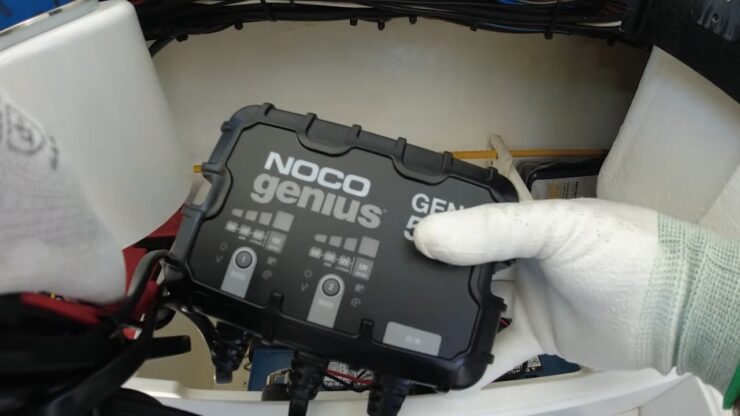
As we mentioned earlier, solar panels bring efficiency. But the unreliability of it makes the outboard take the helms.
But there are some components needed for the outboard motor to charge the batteries. Those being;
- An electrical generator with a coil. The electricity is produced as the generator rotates the motors.
- A regulator or rectifier. A regulator converts the pulsating waves of the AC current into a constant direct current. This procedure is suitable for batteries.
Once you can gather all the necessary tools, it’s a 10 minutes task for you.
Mount your heavy-duty waterproof connector in the hull. Therefore, the disconnection and reconnection process will become much easier for you. Also, you are not required to do any drilling which are unnecessary. .
Then, put together a 2-wire harness. Preferably out of 12 AWG cables. Insert one end of it to the rectifier or the regulator output. And insert the other one to the grounds on the motor.
The exit of the cable is through the accessible grommet at the front. Before it terminates in a male half of a two-pole connector.
Thirdly, take a 12 gauge duplex cable and run it from the motor to where electricity is required. Attach one side of the outboard connector.
Finally, attach a 10 amp fuse holder to one end of the positive cable. The positive side of the battery’s terminal needs to be connected with the positive side of the cable. .
On the other hand, the negative side of the cable is connected to the bus bar where other wires are connected.
Instructions to Charge Trolling Batteries from Outboard Engine
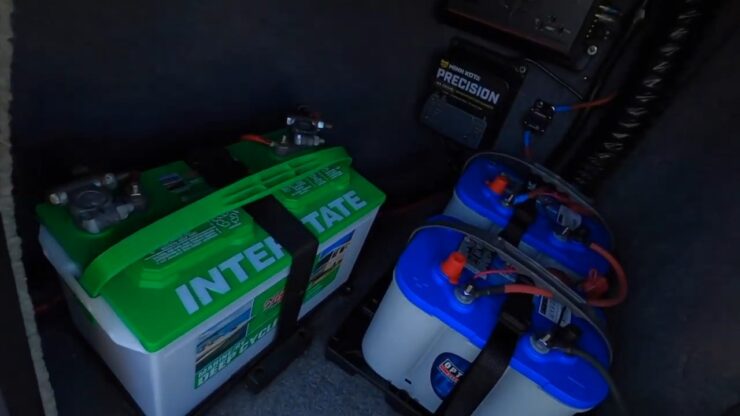
To charge the batteries through the outboard motor, you need to follow some procedures as well. Those being;
Step 1
At first, the battery combiner needs to be mounted within two feet of the starting battery. Usually, the combiners come as waterproof.
Therefore, they are not required to be undercover. Also, the LED helps with the visibility while exposed to direct sunlight.
Step 2
Identify the red cable. Then connect it with the starting battery’s positive side of the terminal. Both leads of the cable can be interchangeably used with a 100 amp connector.
Step 3
The third step would be to connect the other red end to the troll battery’s positive terminal. Use an extension cable if you want it to mount to the bow.
Subsequently, all the negative ends need to be connected together through a duplex wire. A 12 gauge duplex wire would be the best one to use for this job
Ensure to leave enough space so that nothing remains short.
Step 4
Now connect the negative terminals to both batteries. As a result, the path for returning charging currents will be created.
Ensure that your cables don’t suffer any damage. Otherwise, you will face major consequences. Especially if your boat is made of metal.
Step 5
Now connect the black terminal lead to the negative lead of your starting batteries. Use a shortened cable. But don’t short too much that it disrupts your connection.
Step 6
Finally cut 2 or 3 inches of green wire and wrap it with electrical tape. Ensure that it is completely restricted from any sort of contact.
I hope these suggestions were useful.
These are the steps that you need to follow in order to set your outboard motor. So, it can charge your batteries.
How Long Does It Take for an Outboard to Charge a Battery?
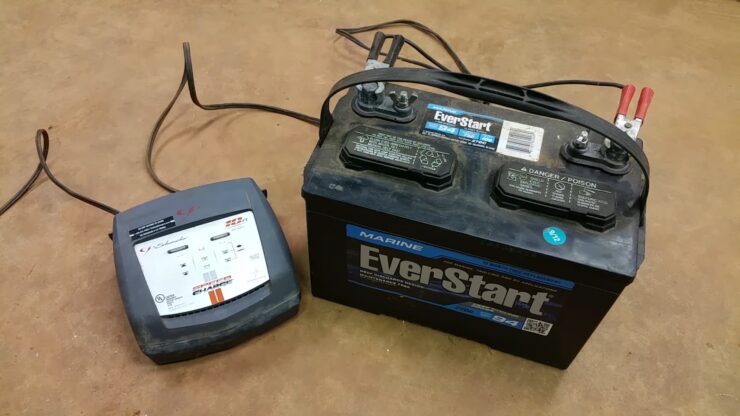
It’s crucial to be aware of the time required to recharge marine batteries. Your battery’s quality and the current you’re using are two very important aspects to take into account. How long it takes to recharge marine batteries is explained here:
It typically takes 4-6 hours.
A marine battery will typically require 4-6 hours to fully charge. This will charge your battery from zero to eighty percent. Furthermore, it depends on the kind of charger you’re utilizing. Considering that certain chargers are more effective than others, choosing a high-quality charger is crucial.
It is dependent upon how well the battery is maintained.
The time it takes to recharge the marine battery that powers your boat will be less if you maintain it properly. This is due to the fact that regular maintenance will lower internal resistance, which will result in noticeably quicker charging times.
Selecting the appropriate battery is crucial.
The time it takes to charge a battery will be shorter if the battery is made to have less internal resistance. Furthermore, batteries that are constructed to a high level of general quality will probably charge more quickly than those that aren’t.
There is a discrepancy in the ambient temperature
It will take roughly 4-6 hours to fully charge a battery at room temperature using a regular size charger. The amount of current you use might need to be reduced, though, if you’re charging your battery in a chilly environment. In general, you should charge your battery at temperatures that are between 50 and 86 degrees, which often means that it’s best to charge them indoor.
Therefore, it does not overcharge and ruins your battery. Another important thing is, that you better know how to charge your battery on water.
FAQs
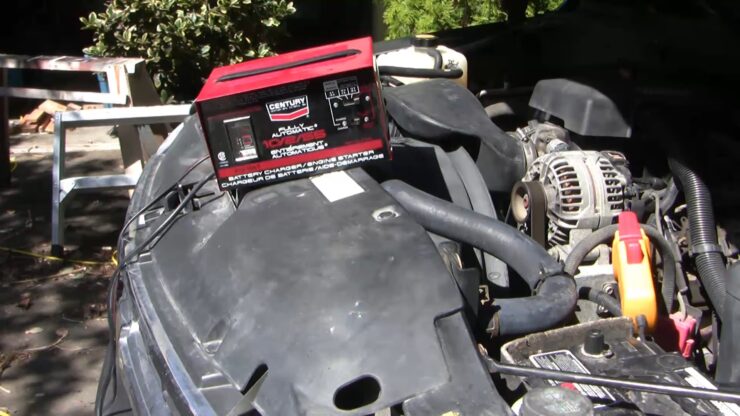
Will my outboard charge my battery?
Yes. Most outboard motors can charge your batteries. Even if they don’t have an electrical starter they can, the process is relatively similar to your car charging the batteries. For any large displacement outboard motor, this is a rule.
Will an outboard motor charge a deep cycle battery?
Trolling motor deep cycle batteries will not be charged by the outboard motor, most of the amps from the alternation will be required to start the engine. Therefore, there will be no residual electricity available to charge the deep cycle batteries.
Do the boat battery charge while the engine is running?
The alternator will start charging the batteries once the outboard is on. This compensates for the power which was delivered to start the motor. Also, any other power is drawn that the house needs.
How do I know when my boat battery is fully charged?
Do an open-circuit voltage test with a multimeter. This will show you whether your boat has a reliable power source. It will inform you of the battery’s charge level. The battery is fully charged if the test results show a charge of 12.6 volts or more.
Endnote
This is all from our end. I hope now you are clear about “does my motor boat charge my batteries?”
Now that you are well informed on it. You can take necessary measurements in terms of charging your boat batteries. Having a properly charged battery can make your boat riding much smoother.
So long for today. Until next time, have a lovely day!
If you like this article read more here about outboard carburetor problems.
I’m Liam Jackson, the proud owner and driving force behind KayakPaddling.net. Born somewhere in the expansive beauty of the United States, I’ve nurtured a lifelong passion for kayaking and fishing that has led me to explore the far corners of our nation’s waterways.
Related Posts:
- Alternator Field Disconnect - Do You Need To Use It?
- How to Charge A Boat Battery on the Water? 2024 - In…
- Do Outboard Motors Have Alternators? -Knowing…
- Johnson Outboard Charging System - Common Problems…
- Exceeding Max HP Rating on Boat: All You Need to Know!
- Livingston Boat Modifications: Things You Can Add

